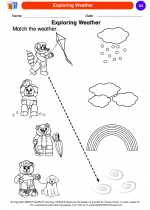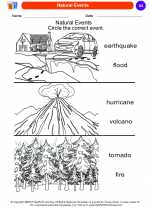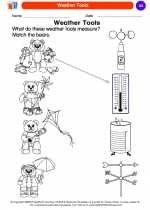Weather -> convection currents
Convection Currents
Convection currents are a crucial concept in understanding how heat is transferred in fluids, such as liquids and gases. These currents occur as a result of the movement of the fluid due to differences in temperature and density within the fluid.
How do Convection Currents Work?
Convection currents are driven by the unequal heating of a fluid. When a portion of the fluid, such as air or water, is heated, it becomes less dense and tends to rise. As it rises, it displaces the cooler, denser fluid above it, which then sinks to replace the warm fluid. This creates a continuous circular motion known as a convection current.
Examples of Convection Currents
One common example of convection currents is the heating of air in a room. When a heater warms the air near the floor, the warm air rises, creating a convection current that circulates the air in the room, leading to a more even distribution of heat.
Another example is the heating of water in a pot. As the water near the heat source becomes warmer, it rises, while the cooler, denser water moves down to take its place. This creates a circular motion that helps to distribute the heat throughout the pot.
Study Guide
- Define convection currents and explain how they are formed.
- Describe a real-life example of convection currents in action.
- Explain the role of convection currents in redistributing heat in the atmosphere and oceans.
- Discuss the importance of convection currents in natural phenomena such as weather patterns and ocean currents.
- Compare and contrast convection currents in liquids and gases, highlighting any similarities and differences.
- Propose an experiment to demonstrate convection currents and explain the expected results.
Understanding convection currents is essential for comprehending heat transfer and fluid dynamics. By grasping the principles behind convection currents, you'll gain insights into various natural phenomena and practical applications in everyday life.
[Convection Currents] Related Worksheets and Study Guides:
.◂Science Worksheets and Study Guides Kindergarten. Weather

 Coloring Worksheet
Coloring Worksheet
 Coloring Worksheet
Coloring Worksheet
 Coloring Worksheet
Coloring Worksheet
 Coloring Worksheet
Coloring Worksheet
 Coloring Worksheet
Coloring Worksheet
 Coloring Worksheet
Coloring Worksheet
 Coloring Worksheet
Coloring Worksheet
 Coloring Worksheet
Coloring Worksheet
 Coloring Worksheet
Coloring Worksheet
 Coloring Worksheet
Coloring Worksheet
 Coloring Worksheet
Coloring Worksheet
 Coloring Worksheet
Coloring Worksheet
 Coloring Worksheet
Coloring Worksheet
 Coloring Worksheet
Coloring Worksheet
 Coloring Worksheet
Coloring Worksheet
 Coloring Worksheet
Coloring Worksheet
 Coloring Worksheet
Coloring Worksheet
 Coloring Worksheet
Coloring Worksheet
 Coloring Worksheet
Coloring Worksheet
